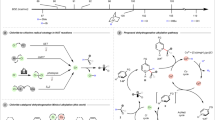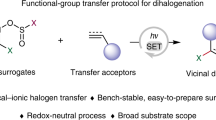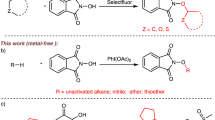Abstract
Acceptorless dehydrogenative cross-coupling between two carbon–hydrogen (C–H) bonds has garnered increasing attention in synthetic chemistry. Cross-coupling of this type does not require the use of functionalized reactive reagents such as organic halides and organometallics. In addition, acceptorless dehydrogenation can proceed without external oxidants, releasing molecular hydrogen as the sole by-product. These features enable target molecules to be accessed with fewer synthetic steps and reduced waste. For the development of dehydrogenative cross-coupling reactions, viable methodologies for the cleavage of C–H bonds are crucial. Hydrogen-atom transfer (HAT) catalysis has significant potential because a diverse range of hydrocarbons can be subjected to HAT. This Perspective describes the use of photoinduced HAT catalysis in acceptorless dehydrogenative reactions, with the aim of providing an opportunity to consider the future prospects of this methodology.

This is a preview of subscription content, access via your institution
Access options
Subscribe to this journal
Receive 12 digital issues and online access to articles
$119.00 per year
only $9.92 per issue
Buy this article
- Purchase on Springer Link
- Instant access to full article PDF
Prices may be subject to local taxes which are calculated during checkout




Similar content being viewed by others
References
Li, C. J. Cross-dehydrogenative coupling (CDC): exploring C–C bond formations beyond functional group transformations. Acc. Chem. Res. 42, 335–344 (2009).
Le Bras, J. & Muzart, J. Intermolecular dehydrogenative Heck reactions. Chem. Rev. 111, 1170–1214 (2011).
Girard, S. A., Knauber, T. & Li, C. J. The cross-dehydrogenative coupling of C(sp3)–H bonds: a versatile strategy for C–C bond formations. Angew. Chem. Int. Ed. 53, 74–100 (2014).
Liu, C. et al. Oxidative coupling between two hydrocarbons: an update of recent C–H functionalizations. Chem. Rev. 115, 12138–12204 (2015).
Trost, B. M. The atom economy: a search for synthetic efficiency. Science 254, 1471–1477 (1991).
Chen, B., Wu, L.-Z. & Tung, C.-H. Photocatalytic activation of less reactive bonds and their functionalization via hydrogen-evolution cross-couplings. Acc. Chem. Res. 51, 2512–2523 (2018).
Siddiki, S. M. A. H., Toyao, T. & Shimizu, K. Acceptorless dehydrogenative coupling reactions with alcohols over heterogeneous catalysts. Green Chem. 20, 2933–2952 (2018).
Tang, S., Zeng, L. & Lei, A. Oxidative R1–H/R2–H cross-coupling with hydrogen evolution. J. Am. Chem. Soc. 140, 13128–13135 (2018).
Wang, H., Gao, X., Lv, Z., Abdelilah, T. & Lei, A. Recent advances in oxidative R1–H/R2–H cross-coupling with hydrogen evolution via photo-/electrochemistry. Chem. Rev. 119, 6769–6787 (2019).
Maji, M., Panja, D., Borthakur, I. & Kundu, S. Recent advances in sustainable synthesis of N-heterocycles following acceptorless dehydrogenative coupling protocol using alcohols. Org. Chem. Front. 8, 2673–2709 (2021).
Gandeepan, P. et al. 3d transition metals for C–H activation. Chem. Rev. 119, 2192–2452 (2019).
Li, X. et al. Recent development on Cp*Ir(III)-catalyzed C–H bond functionalization. ChemCatChem 12, 2358–2384 (2020).
Tzirakis, M. D., Lykakis, I. N. & Orfanopoulos, M. Decatungstate as an efficient photocatalyst in organic chemistry. Chem. Soc. Rev. 38, 2609–2621 (2009).
Ravelli, D., Fagnoni, M., Fukuyama, T., Nishikawa, T. & Ryu, I. Site-selective C–H functionalization by decatungstate anion photocatalysis: synergistic control by polar and steric effects expands the reaction scope. ACS Catal. 8, 701–713 (2018).
Capaldo, L., Quadri, L. L. & Ravelli, D. Photocatalytic hydrogen atom transfer: the philosopher’s stone for late-stage functionalization? Green Chem. 22, 3376–3396 (2020).
Zhang, D., Hui, X., Wu, C. & Zhu, Y. Metal-catalyzed hydrogen evolution reactions involving strong C–H bonds activation via hydrogen atom transfer. ChemCatChem 13, 3370–3380 (2021).
Dobereiner, G. E. & Crabtree, R. H. Dehydrogenation as a substrate-activating strategy in homogeneous transition-metal catalysis. Chem. Rev. 110, 681–703 (2010).
Crabtree, R. H. Homogeneous transition metal catalysis of acceptorless dehydrogenative alcohol oxidation: applications in hydrogen storage and to heterocycle synthesis. Chem. Rev. 117, 9228–9246 (2017).
Mukherjee, A. & Milstein, D. Homogeneous catalysis by cobalt and manganese pincer complexes. ACS Catal. 8, 11435–11469 (2018).
West, J. G., Huang, D. & Sorensen, E. J. Acceptorless dehydrogenation of small molecules through cooperative base metal catalysis. Nat. Commun. 6, 10093 (2015).
Zhao, L.-M. et al. Photocatalysis with quantum dots and visible light: selective and efficient oxidation of alcohols to carbonyl compounds through a radical relay process in water. Angew. Chem. Int. Ed. 56, 3020–3024 (2017).
Kato, S. et al. Hybrid catalysis enabling room-temperature hydrogen gas release from N-heterocycles and tetrahydronaphthalenes. J. Am. Chem. Soc. 139, 2204–2207 (2017).
Fuse, H., Kojima, M., Mitsunuma, H. & Kanai, M. Acceptorless dehydrogenation of hydrocarbons by noble-metal free hybrid catalyst system. Org. Lett. 20, 2042–2045 (2018).
Fuse, H., Mitsunuma, H. & Kanai, M. Catalytic acceptorless dehydrogenation of aliphatic alcohols. J. Am. Chem. Soc. 142, 4493–4499 (2020).
Nikolaienko, P., Jentsch, M., Kale, A. P., Cai, Y. & Rueping, M. Electrochemical and scalable dehydrogenative C(sp3)–H amination via remote hydrogen atom transfer in batch and continuous flow. Chem. Eur. J. 25, 7177–7184 (2019).
McManus, J. B., Griffin, J. D., White, A. R. & Nicewicz, D. A. Homobenzylic oxygenation enabled by dual organic photoredox and cobalt catalysis. J. Am. Chem. Soc. 142, 10325–10330 (2020).
Zhou, M.-J., Zhang, L., Liu, G., Xu, C. & Huang, Z. Site-selective acceptorless dehydrogenation of aliphatics enabled by organophotoredox/cobalt dual catalysis. J. Am. Chem. Soc. 143, 16470–16485 (2021).
Dempsey, J. L., Brunschwig, B. S., Winkler, J. R. & Gray, H. B. Hydrogen evolution catalyzed by cobaloximes. Acc. Chem. Res. 42, 1995–2004 (2009).
Ravelli, D., Protti, S. & Fagnoni, M. Decatungstate anion for photocatalyzed ‘window ledge’ reactions. Acc. Chem. Res. 49, 2232–2242 (2016).
Cao, H. et al. Photoinduced site-selective alkenylation of alkanes and aldehydes with aryl alkenes. Nat. Commun. 11, 1956 (2020).
Lacy, D. C., Roberts, G. M. & Peters, J. C. The cobalt hydride that never was: revisiting Schrauzer’s ‘hydridocobaloxime’. J. Am. Chem. Soc. 137, 4860–4864 (2015).
Estes, D. P., Grills, D. C. & Norton, J. R. The reaction of cobaloximes with hydrogen: products and thermodynamics. J. Am. Chem. Soc. 136, 17362–17365 (2014).
Shaw, M. H., Twilton, J. & MacMillan, D. W. C. Photoredox catalysis in organic chemistry. J. Org. Chem. 81, 6898–6926 (2016).
Yu, W.-L. et al. Dehydrogenative silylation of alkenes for the synthesis of substituted allylsilanes by photoredox, hydrogen-atom transfer, and cobalt catalysis. Angew. Chem. Int. Ed. 58, 10941–10945 (2019).
Uoyama, H., Goushi, K., Shizu, K., Nomura, H. & Adachi, C. Highly efficient organic light-emitting diodes from delayed fluorescence. Nature 492, 234–238 (2012).
Luo, J. & Zhang, J. Donor–acceptor fluorophores for visible-light-promoted organic synthesis: photoredox/Ni dual catalytic C(sp3)–C(sp2) cross-coupling. ACS Catal. 6, 873–877 (2016).
Jeffrey, J. L., Terrett, J. A. & MacMillan, D. W. C. O–H hydrogen bonding promotes H-atom transfer from α C–H bonds for C-alkylation of alcohols. Science 349, 1532–1536 (2015).
Huang, C.-Y., Li, J. & Li, C.-J. A cross-dehydrogenative C(sp3)–H heteroarylation via photo-induced catalytic chlorine radical generation. Nat. Commun. 12, 4010 (2021).
McCallum, T., Pitre, S. P., Morin, M., Scaiano, J. C. & Barriault, L. The photochemical alkylation and reduction of heteroarenes. Chem. Sci. 8, 7412–7118 (2017).
Li, D.-S. et al. Stop-flow microtubing reactor-assisted visible light-induced hydrogen-evolution cross coupling of heteroarenes with C(sp3)–H bonds. ACS Catal. 12, 4473–4480 (2022).
Xue, F. et al. Reaction discovery using acetylene gas as the chemical feedstock accelerated by the ‘stop-flow’ micro-tubing reactor system. Chem. Sci. 8, 3623–3627 (2017).
Darcy, J. W., Koronkiewicz, B., Parada, G. A. & Mayer, J. M. A continuum of proton-coupled electron transfer reactivity. Acc. Chem. Res. 51, 2391–2399 (2018).
Murray, P. R. D. et al. Photochemical and electrochemical applications of proton-coupled electron transfer in organic synthesis. Chem. Rev. 122, 2017–2291 (2022).
Bodedla, G. B. et al. Cocatalyst-free photocatalytic hydrogen evolution with simple heteroleptic iridium(III) complexes. ACS Appl. Energy Mater. 4, 3945–3951 (2021).
Ohmatsu, K., Suzuki, R., Furukawa, Y., Sato, M. & Ooi, T. Zwitterionic 1,2,3-triazolium amidate as a catalyst for photoinduced hydrogen-atom transfer radical alkylation. ACS Catal. 10, 2627–2632 (2020).
Minami, K., Ohmatsu, K. & Ooi, T. Hydrogen-atom-transfer-mediated acceptorless dehydrogenative cross-coupling enabled by multiple catalytic functions of zwitterionic triazolium amidate. ACS Catal. 12, 1971–1976 (2022).
Kawasaki, T., Ishida, N. & Murakami, M. Dehydrogenative coupling of benzylic and aldehydic C–H bonds. J. Am. Chem. Soc. 142, 3366–3370 (2020).
Kawasaki, T., Ishida, N. & Murakami, M. Photoinduced specific acylation of phenolic hydroxy groups with aldehydes. Angew. Chem. Int. Ed. 59, 18267–18271 (2020).
Kawasaki, T., Tosaki, T., Ishida, N. & Murakami, M. Visible-light-driven dehydrogenative coupling of primary alcohols with phenols forming aryl carboxylates. Org. Lett. 23, 7683–7687 (2021).
Acknowledgements
This report was prepared as an account of work supported by JSPS KAKENHI Grant Number JP17H06446 in Hybrid Catalysis for Enabling Molecular Synthesis on Demand and JP21H01930.
Author information
Authors and Affiliations
Contributions
K.O. and T.O. contributed to discussions and wrote the manuscript.
Corresponding author
Ethics declarations
Competing interests
The authors declare no competing interests.
Peer review
Peer review information
Nature Synthesis thanks Chao-Jun Li and the other, anonymous, reviewer(s) for their contribution to the peer review of this work. Primary Handling Editor: Thomas West, in collaboration with the Nature Synthesis team.
Additional information
Publisher’s note Springer Nature remains neutral with regard to jurisdictional claims in published maps and institutional affiliations.
Rights and permissions
Springer Nature or its licensor (e.g. a society or other partner) holds exclusive rights to this article under a publishing agreement with the author(s) or other rightsholder(s); author self-archiving of the accepted manuscript version of this article is solely governed by the terms of such publishing agreement and applicable law.
About this article
Cite this article
Ohmatsu, K., Ooi, T. Catalytic acceptorless dehydrogenative coupling mediated by photoinduced hydrogen-atom transfer. Nat. Synth 2, 209–216 (2023). https://doi.org/10.1038/s44160-022-00195-1
Received:
Accepted:
Published:
Issue Date:
DOI: https://doi.org/10.1038/s44160-022-00195-1



